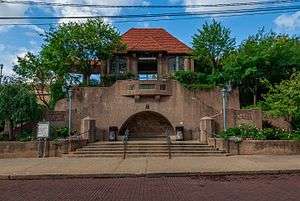Forest Hills (LIRR station)
Forest Hills | |||||||||||||||||||||
|---|---|---|---|---|---|---|---|---|---|---|---|---|---|---|---|---|---|---|---|---|---|
 Forest Hills LIRR Station South Entrance | |||||||||||||||||||||
| Location |
Continental (71st) Avenue & Austin Street Forest Hills, New York | ||||||||||||||||||||
| Coordinates | 40°43′10″N 73°50′42″W / 40.719483°N 73.844883°WCoordinates: 40°43′10″N 73°50′42″W / 40.719483°N 73.844883°W | ||||||||||||||||||||
| Owned by | Long Island Rail Road | ||||||||||||||||||||
| Line(s) | |||||||||||||||||||||
| Platforms | 2 side platforms | ||||||||||||||||||||
| Tracks | 4 | ||||||||||||||||||||
| Connections |
New York City Subway: | ||||||||||||||||||||
| Construction | |||||||||||||||||||||
| Disabled access | Yes | ||||||||||||||||||||
| Other information | |||||||||||||||||||||
| Fare zone | 1 | ||||||||||||||||||||
| History | |||||||||||||||||||||
| Opened | 1906 | ||||||||||||||||||||
| Closed | 1911 | ||||||||||||||||||||
| Rebuilt | August 5, 1911 | ||||||||||||||||||||
| Electrified |
June 16, 1910 750 V (DC) third rail | ||||||||||||||||||||
| Traffic | |||||||||||||||||||||
| Passengers (2006) | 1,116[1] | ||||||||||||||||||||
| Services | |||||||||||||||||||||
| |||||||||||||||||||||
Forest Hills is a station on the Main Line of the Long Island Rail Road in Forest Hills. Like other LIRR stations within New York City, passengers may take advantage of the CityTicket program on weekends. It is lightly used compared to other stations in the city, with only 1,116 weekday riders; many residents opt for the subway because of its increased service and direct express trains to Midtown Manhattan.
Location
Located in the neighborhood of Queens of the same name, Forest Hills is situated on 71st Avenue (formerly known as Continental Avenue) between Austin and Burns Streets. It is also the northern boundary of Station Square, a historic Tudor town center, which was across from a building known as the "Forest Hills Inn."[2] The station is also just east of the West Side Tennis Club. Two blocks to the north along 71st Avenue is the Forest Hills – 71st Avenue subway station, one of the busiest in Queens.
History
Opened in 1906, Forest Hills is one of the oldest operating railway stations in New York City, predating subway expansion to the area by thirty years. Rebuilt in 1911 and subsequently remodeled for handicapped accessibility, it is one of two LIRR stations without standard blue and white signage (the other is Nostrand Avenue). Instead there are plaques and antique signs that complement the surrounding area. On July 4, 1917, former President Theodore Roosevelt made his "Unification Speech" from the steps of this station.[3]
Station layout
| 3 | ■ Main Line | toward Penn Station (Woodside) |
| 1 | ■ Main Line | no stop |
| 2 | ■ Main Line | no stop |
| 4 | ■ Main Line | toward Long Island (Kew Gardens) |
A local station, Forest Hills has two side platforms and four tracks. Platform A serves westbound trains to Penn Station, while Platform B serves eastbound trains to the suburbs of Long Island; both are four cars long. The two inner tracks are used by express trains, although bridge plates are occasionally used to bridge over an outer track during track work. The relatively flat and straight stretch of track at Forest Hills has been used for PATH PA-1 and R44 speed tests.[4][5]
Gallery
 Seen from Station Plaza
Seen from Station Plaza At Station Square
At Station Square Station Square from Greenway Terrace
Station Square from Greenway Terrace
References
- ↑ Average weekday, 2006 LIRR Origin and Destination Study
- ↑ History of Station Square (Friends of Station Square)
- ↑ Morrison, David D.; Pakaluk, Valerie (2003). Long Island Rail Road Stations. Images of Rail. Arcadia Publishing. p. 39. ISBN 0-7385-1180-3.
- ↑ "world.nycsubway.org/Showing Image 21781". nycsubway.org.
- ↑ "Showing Image 7650". nycsubway.org.
External links
| Wikimedia Commons has media related to Forest Hills (LIRR station). |
- Official LIRR station information page for Forest Hills
- Station timetable for Forest Hills
- Forest Hills Station (The SubwayNut)
- Burns Street entrance from Google Maps Street View
- Continental Avenue entrance from Google Maps Street View
- Platforms from Google Maps Street View